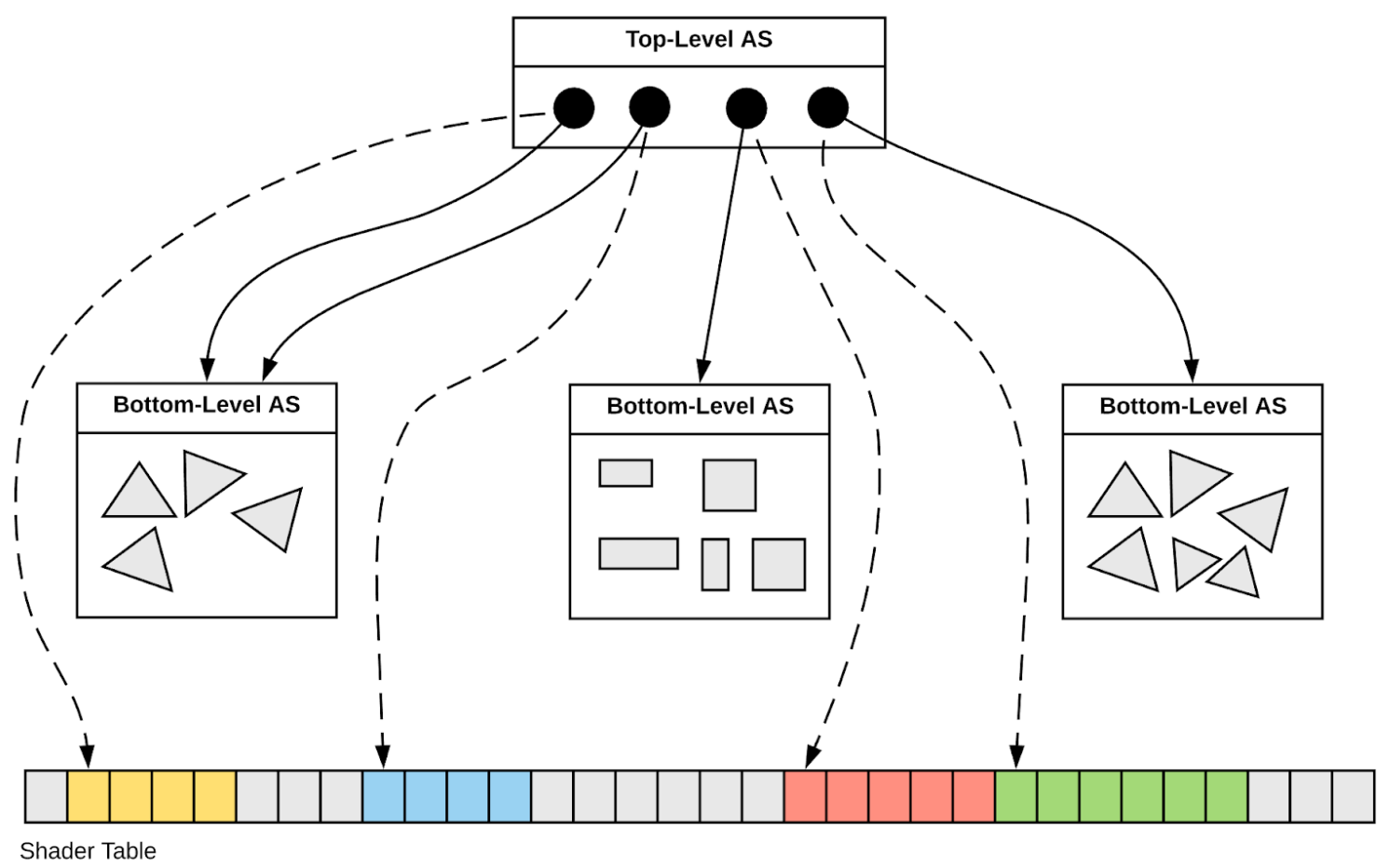LZ-Opticks-NVIDIA OptiX 6->7 : Notes
- https://github.com/simoncblyth/CSG/commits https://github.com/simoncblyth/CSGOptiX/commits
- https://github.com/simoncblyth/CSG_GGeo/commits
PROGRESS : OptiXTest -> CSG + CSGOptiX, added CSG_GGeo
- CSG : CSGFoundry model, simple intersect headers : CPU testable
- CSG_GGeo : loads Opticks/GGeo, converts to CSG
- CSGOptiX : OptiX 7 + pre-7 renders of CSGFoundry geometry
NEXT STEPS:
- investigate 2 slow solids in JUNO geometry, try different instance criteria, modelling
- systematic comparison of render times with 6 and 7 : stack size tuning
- reduce CSGOptiX code ~duplicated between pre-7:Six.cc, 7:SBT.cc : unify code in common
- bring over event handling (photon generation + propagation)
- pull out simple headers common to: pre-7, 7, CPU testing (minimize code difference between envs)
- trickery/mocking needed for CURAND on CPU? (templating?)
- integrate packages with Opticks
LONGTERM POSSIBILITY : Populate CSGFoundry model direct from Geant4 geometry ? [Disruptive]
New "Foundry" Model : Shared CPU/GPU Geometry Context
IAS < Inst < Solid < Prim < Node
- Inst : 4x4 tran. + Solid ref. ( Inst -> 1 IAS )
- Solid : 1 or more Prim : ( Solid -> GAS )
- Prim : 1,3,7,15,31,... Node : (Prim ~ G4VSolid)
struct CSGFoundry
{
void upload(); // to GPU
...
std::vector<CSGSolid> solid ; // compounds (eg PMT)
std::vector<CSGPrim> prim ;
std::vector<CSGNode> node ; // shapes, operators
std::vector<float4> plan ; // planes
std::vector<qat4> tran ; // CSG transforms
std::vector<qat4> itra ; // inverse CSG transforms
std::vector<qat4> inst ; // instance transforms
// entire geometry in four GPU allocations
CSGPrim* d_prim ;
CSGNode* d_node ;
float4* d_plan ;
qat4* d_itra ;
};
referencing by offset, count
- replaces geometry context dropped in OptiX 6->7
- array-based -> simple, inherent serialization + persisting
- entire geometry in 4 GPU allocations
Simple intersect headers, common CPU/GPU types
- use with : pre-7, 7 + testing on CPU
- https://github.com/simoncblyth/CSG "Foundry" model
- csg_intersect_tree.h/csg_intersect_node.h/...
- simple headers common to pre-7/7/CPU-testing
- https://github.com/simoncblyth/CSG_GGeo
- Convert Opticks/GGeo -> CSGFoundry
- https://github.com/simoncblyth/CSGOptiX
- OptiX 7 + pre-7 rendering
GAS : Geometry Acceleration Structure
IAS : Instance Acceleration Structure
CSG : Constructive Solid Geometry
OptiX 7 + pre-7 intersecting same CSGFoundry geometry
geo_OptiX6Test.cu
- Duplicate 7 environment in pre-7
24 rtBuffer<CSGPrim> prim_buffer; // geometry level context 25 28 rtBuffer<CSGNode> node_buffer; // global context 29 rtBuffer<qat4> itra_buffer; 30 rtBuffer<float4> plan_buffer; .. 40 RT_PROGRAM void intersect(int primIdx) 41 { 42 const CSGPrim* prim = &prim_buffer[primIdx] ; 43 int nodeOffset = prim->nodeOffset() ; 44 int numNode = prim->numNode() ; 45 const CSGNode* node = &node_buffer[nodeOffset] ; 46 const float4* plan = &plan_buffer[0] ; 47 const qat4* itra = &itra_buffer[0] ; 48 49 float4 isect ; 50 if(intersect_prim(isect, numNode, node, plan, itra, ray.tmin , ray.origin, ray.direction )) 51 { 52 if(rtPotentialIntersection(isect.w)) 53 { 55 shading_normal = make_float3( isect ); 57 rtReportIntersection(0); 58 } 59 } 60 }
- https://github.com/simoncblyth/CSGOptiX
OptiX7Test.cu
150 extern "C" __global__ void __intersection__is()
151 {
152 HitGroupData* hg = (HitGroupData*)optixGetSbtDataPointer();
153 int numNode = hg->numNode ;
154 int nodeOffset = hg->nodeOffset ;
155
156 const CSGNode* node = params.node + nodeOffset ;
157 const float4* plan = params.plan ;
158 const qat4* itra = params.itra ;
159
160 const float t_min = optixGetRayTmin() ;
161 const float3 ray_origin = optixGetObjectRayOrigin();
162 const float3 ray_direction = optixGetObjectRayDirection();
163
164 float4 isect ;
165 if(intersect_prim(isect, numNode, node, plan, itra,
t_min , ray_origin, ray_direction ))
166 {
...
175 optixReportIntersection( isect.w, hitKind, a0, a1, a2, a3 );
176 }
177 }
Minimize code split : 7, pre-7, CPU testing : same intersect_prim
CSG_GGeo : loads Opticks/GGeo, converts to CSGFoundry model
Converter : GGeo/GParts -> CSG
struct CSG_GGeo_Convert
{
CSGFoundry* foundry ;
const GGeo* ggeo ;
const Opticks* ok ;
..
CSG_GGeo_Convert(CSGFoundry* foundry, const GGeo* ggeo ) ;
void init();
void convert(int repeatIdx=-1, int primIdx=-1, int partIdxRel=-1 );
void convert_();
CSGSolid* convert_(unsigned repeatIdx );
void addInstances(unsigned repeatIdx );
CSGPrim* convert_(const GParts* comp, unsigned primIdx );
CSGNode* convert_(const GParts* comp, unsigned primIdx, unsigned partIdxRel );
// below called non-standardly when corresponding envvars defined
void addOnePrimSolid();
void addOnePrimSolid(unsigned solidIdx);
void addOneNodeSolid();
void addOneNodeSolid(unsigned solidIdx);
void addOneNodeSolid(unsigned solidIdx, unsigned primIdx, unsigned primIdxRel);
void addDeepCopySolid();
void kludgeScalePrimBBox();
};
- https://github.com/simoncblyth/CSG_GGeo
..
11 int main(int argc, char** argv)
12 {
13 OPTICKS_LOG(argc, argv);
14
15 Opticks ok(argc, argv);
16 ok.configure();
17
18 GGeo* ggeo = GGeo::Load(&ok);
19
20 CSGFoundry foundry ;
21 CSG_GGeo_Convert conv(&foundry, ggeo) ;
22 conv.convert();
...
39 foundry.write(cfbase, rel );
40
41 CSGFoundry* fd = CSGFoundry::Load(cfbase, rel);
42 assert( 0 == CSGFoundry::Compare(&foundry, fd ) );
43
44 return 0 ;
45 }
- GGeo::Load geocache identified by OPTICKS_KEY envvar
- LONGTERM: direct Geant4 -> CSG ? disruptive
- disruptive but allows big code reductions in NPY/NNode
[9]cxr_i0_t8,_-1 : EXCLUDE SLOWEST
1st JUNO Opticks OptiX 7 Ray-trace
Very New CSG "Foundry" CPU/GPU Geometry
- purely analytic CSG, no triangles
- everything at default, no optimization
Current JUNO Geometry : Auto-Factorized by "progeny digest"
Factorize ~300,000 vol -> 10 comp
- ridx: repeat index
- plc: number of placements of the instance
- prim: number of Prim/volumes in the instance
- component: numPrim:outerPrimName
"progeny digest" characterizes subtree of every volume-node
| ridx | plc | prim | component | note |
|---|---|---|---|---|
| 0 | 1 | 3084 | 3084:sWorld | non-repeated remainder |
| 1 | 25600 | 5 | 5:PMT_3inch_pmt_solid | 4 types of PMT |
| 2 | 12612 | 5 | 5:NNVTMCPPMTsMask | |
| 3 | 5000 | 5 | 5:HamamatsuR12860sMask | |
| 4 | 2400 | 5 | 5:mask_PMT_20inch_vetosMask | |
| 5 | 590 | 1 | 1:sStrutBallhead | 4 parts of same assembly, BUT not grouped as siblings (not parent-child) |
| 6 | 590 | 1 | 1:uni1 | |
| 7 | 590 | 1 | 1:base_steel | |
| 8 | 590 | 1 | 1:uni_acrylic3 | |
| 9 | 504 | 130 | 130:sPanel | repeated parts of TT |
- ridx:0 "remainder" Prim
- Prim that did not pass instancing criteria, on number of repeats + complexity
- TODO: tune criteria to instance more, reducing remainder Prim (Expect: 3084->~ 84)
- ridx:1,2,3,4
- four types of PMT, all with 5 Prim
- ridx:5,6,7,8
- same 590x assembly but not grouped together : as siblings (not parent-child like PMTs)
- TODO: implement instancing of siblings, combining 4 -> 1
Increasing instancing : reduces memory for geometry -> improved performance
JUNO OptiX 7 : "Foundry" Geometry Scan
Vary Geom. Compare Render Times
Fast render -> Fast simulation
JUNO Geometry : OptiX 7 Ray Trace Times ~2M pixels : TITAN RTX
Same viewpoint, vary GPU geometry
- -e : controls components : "t" means ~ (NOT)
- time(s) : GPU ray trace CUDA launch time
- relative : compares to "ONLY PMT" baseline
Very large range of times 1:600
Table identifies slow geometry to fix :
- 3084:sWorld (too many non-instanced Prim)
- 1:uni_acrylic (CSG sub. 35m diam. sphere)
Good performance for ONLY PMTs :
- 45,612 PMT instances handled without issue
| idx | -e | time(s) | relative | enabled geometry description |
|---|---|---|---|---|
| 0 | 9, | 0.0017 | 0.1702 | ONLY: 130:sPanel |
| 1 | 7, | 0.0017 | 0.1714 | ONLY: 1:base_steel |
| 2 | 6, | 0.0019 | 0.1923 | ONLY: 1:uni1 |
| 3 | 5, | 0.0027 | 0.2780 | ONLY: 1:sStrutBallhead |
| 4 | 4, | 0.0032 | 0.3268 | ONLY: 5:mask_PMT_20inch_vetosMask |
| 5 | 1, | 0.0032 | 0.3287 | ONLY: 5:PMT_3inch_pmt_solid |
| 6 | 2, | 0.0055 | 0.5669 | ONLY: 5:NNVTMCPPMTsMask |
| 7 | 3, | 0.0074 | 0.7582 | ONLY: 5:HamamatsuR12860sMask |
| 8 | 1,2,3,4 | 0.0097 | 1.0000 | ONLY PMT |
| 9 | t8,0 | 0.0099 | 1.0179 | EXCL: 1:uni_acrylic3 3084:sWorld |
| 10 | 0, | 0.1171 | 12.0293 | ONLY: 3084:sWorld |
| 11 | t8, | 0.1186 | 12.1769 | EXCL: 1:uni_acrylic3 |
| 12 | t0, | 0.5278 | 54.2066 | EXCL: 3084:sWorld |
| 13 | 8, | 0.5310 | 54.5298 | ONLY: 1:uni_acrylic3 |
| 14 | t3, | 0.6017 | 61.7954 | EXCL: 5:HamamatsuR12860sMask |
| 15 | t2, | 0.6043 | 62.0620 | EXCL: 5:NNVTMCPPMTsMask |
| 16 | t5, | 0.6171 | 63.3787 | EXCL: 1:sStrutBallhead |
| 17 | t6, | 0.6196 | 63.6301 | EXCL: 1:uni1 |
| 18 | t7, | 0.6226 | 63.9458 | EXCL: 1:base_steel |
| 19 | t0 | 0.6240 | 64.0879 | 3084:sWorld |
| 20 | t4, | 0.6243 | 64.1169 | EXCL: 5:mask_PMT_20inch_vetosMask |
| 21 | t9, | 0.6335 | 65.0636 | EXCL: 130:sPanel |
| 22 | t1, | 0.6391 | 65.6384 | EXCL: 5:PMT_3inch_pmt_solid |
JUNO ALL PMTs : 2M ray traced pixels in 0.0097 s : NVIDIA TITAN RTX, NVIDIA OptiX 7.0.0, Opticks
[8]cxr_i0_1,2,3,4_-1 ALL PMTs
/env/presentation/cxr/cxr_overview/cxr_i0_1,2,3,4_-1.jpg 1280px_720px
"Flat" look is a bug
Was only rendering the last Prim for GAS after the 1st
CAUSE: using globalPrimIdx for SBTIndexOffset : needs to be GAS local
[10]cxr_i0_0,_-1 ONLY GLOBAL "REMAINDER"
/env/presentation/cxr/cxr_overview/cxr_i0_0,_-1.jpg 1280px_720px
3084 "remainder" non-instance volumes : is far too many
Looks to be obvious repetitions missed by the auto-instancer
[9]cxr_i0_t8,_-1 EXCLUDE SLOWEST 1
/CSG_GGeo/cvd1/70000/cxr_overview/cam_0_tmin_0.4/cxr_overview_emm_t8,_moi_-1.jpg 1280px_720px
Flipping between this and the next, shows the missing Prim bug effect
[9]cxr_i0_t8,_-1 EXCLUDE SLOWEST 2
/env/presentation/cxr/cxr_overview/cxr_i0_t8,_-1.jpg 1280px_720px
Flipping between this and the prev, shows the missing Prim bug effect
cxr_view_0
Inside View with only global remainder geometry
Same viewpoint in OptiX 5,6 and 7
- launch time (s) at bottom left
- OptiX 5 : NVIDIA Geforce 750M (2013 Macbook Pro)
- OptiX 6, 7 : NVIDIA TITAN RTX
cxr_view_1
/CSG_GGeo/cvd0/50001/cxr_view/cam_0_1,/cxr_view_sWaterTube.jpg 640px_360px 640px_0px
/CSG_GGeo/cvd1/60500/cxr_view/cam_0_1,/cxr_view_sWaterTube.jpg 640px_360px 0px_360px
/CSG_GGeo/cvd1/70000/cxr_view/cam_0_1,/cxr_view_sWaterTube.jpg 640px_360px 640px_360px
- OptiX 7 to bottom right, with grey background
- missing Prim bug visible, just get the cylinder Prim
cxr_solid_r1p
These renders use ONE_PRIM_SOLID envvar with the Converter to add CSGFoundry solids containing a single Prim only.
Example solid names: r1p0 r1p1 r1p2 r1p3 r1p4
Then can plot them all using:
./cxr_solid.sh r1p
The argument selects 5 single prim solids and puts them into an IAS with Y-translations.
cxr_view_2
/CSG_GGeo/cvd0/50001/cxr_view/cam_0_2,/cxr_view_sWaterTube.jpg 640px_360px 640px_0px
/CSG_GGeo/cvd1/60500/cxr_view/cam_0_2,/cxr_view_sWaterTube.jpg 640px_360px 0px_360px
/CSG_GGeo/cvd1/70000/cxr_view/cam_0_2,/cxr_view_sWaterTube.jpg 640px_360px 640px_360px
OptiX 5,6,7
Last Prim SBT bug apparent with 7
cxr_solid_r2p
/CSG_GGeo/cvd0/50001/cxr_solid/cam_1/cxr_solid_r2p.jpg 640px_360px 0px_360px
/CSG_GGeo/cvd1/70000/cxr_solid/cam_1/cxr_solid_r2p.jpg 640px_360px 640px_360px
Five of the debug single Prim solids selected with:
./cxr_solid.sh r2p
cxr_view_9
/CSG_GGeo/cvd0/50001/cxr_view/cam_0_9,/cxr_view_sWaterTube.jpg 640px_360px 640px_0px
/CSG_GGeo/cvd1/60500/cxr_view/cam_0_9,/cxr_view_sWaterTube.jpg 640px_360px 0px_360px
/CSG_GGeo/cvd1/70000/cxr_view/cam_0_9,/cxr_view_sWaterTube.jpg 640px_360px 640px_360px
| ridx | plc | prim | component | note |
|---|---|---|---|---|
| 9 | 504 | 130 | 130:sPanel | repeated parts of TT |
Only last of 130 Prim appears (OptiX 7), again due to globalPrimIdx bug
cxr_view_8
/CSG_GGeo/cvd0/50001/cxr_view/cam_0_8,/cxr_view_sWaterTube.jpg 640px_360px 640px_0px
/CSG_GGeo/cvd1/60500/cxr_view/cam_0_8,/cxr_view_sWaterTube.jpg 640px_360px 0px_360px
/CSG_GGeo/cvd1/70000/cxr_view/cam_0_8,/cxr_view_sWaterTube.jpg 640px_360px 640px_360px
Blank render for solid 8 in OptiX 5,6 and 7
[13]lLowerChimney_phys__t5,__00000
Solid 8 "1:uni_acrylic3" is the "plunger" cup that holds the acrylic 35m diameter sphere
[12]lLowerChimney_phys__t0,__00000
Currently the shape does a CSG subtraction with the huge sphere
- enormous Prim BBox ?
[11]lLowerChimney_phys__8,__00000
| ridx | plc | prim | component | note |
|---|---|---|---|---|
| 8 | 590 | 1 | 1:uni_acrylic3 |
590 of these all around the 35m diameter sphere
[10]lLowerChimney_phys__t8,__00000
Has complicated CSG insides too, subtracting the 8 column "greek temple"
cxr_solid_r0@
/CSG_GGeo/cvd0/50001/cxr_solid/cam_1/cxr_solid_r0@_.jpg 640px_360px 640px_0px
/CSG_GGeo/cvd1/60500/cxr_solid/cam_1/cxr_solid_r0@_.jpg 640px_360px 0px_360px
/CSG_GGeo/cvd1/70000/cxr_solid/cam_1/cxr_solid_r0@_.jpg 640px_360px 640px_360px
Argument r0@ matches only solid named "r0"
EYE=0,-1,0 TMIN=1 CAM=1 ./cxr_solid.sh r0@
EYE and TMIN in units of selected solid extent, CAM:0/1 perspective/orthographic
cxr_solid_r1@
/CSG_GGeo/cvd0/50001/cxr_solid/cam_1/cxr_solid_r1@_.jpg 640px_360px 640px_0px
/CSG_GGeo/cvd1/60500/cxr_solid/cam_1/cxr_solid_r1@_.jpg 640px_360px 0px_360px
/CSG_GGeo/cvd1/70000/cxr_solid/cam_1/cxr_solid_r1@_.jpg 640px_360px 640px_360px
Argument r1@ matches only solid named "r1"
EYE=0,-1,0 TMIN=1 CAM=1 ./cxr_solid.sh r1@
cxr_solid_r2@
/CSG_GGeo/cvd0/50001/cxr_solid/cam_1/cxr_solid_r2@_.jpg 640px_360px 640px_0px
/CSG_GGeo/cvd1/60500/cxr_solid/cam_1/cxr_solid_r2@_.jpg 640px_360px 0px_360px
/CSG_GGeo/cvd1/70000/cxr_solid/cam_1/cxr_solid_r2@_.jpg 640px_360px 640px_360px
EYE=0,-1,0 TMIN=1 CAM=1 ./cxr_solid.sh r1@
cxr_solid_r3@
/CSG_GGeo/cvd0/50001/cxr_solid/cam_1/cxr_solid_r3@_.jpg 640px_360px 640px_0px
/CSG_GGeo/cvd1/60500/cxr_solid/cam_1/cxr_solid_r3@_.jpg 640px_360px 0px_360px
/CSG_GGeo/cvd1/70000/cxr_solid/cam_1/cxr_solid_r3@_.jpg 640px_360px 640px_360px
cxr_solid_r4@
/CSG_GGeo/cvd0/50001/cxr_solid/cam_1/cxr_solid_r4@_.jpg 640px_360px 640px_0px
/CSG_GGeo/cvd1/60500/cxr_solid/cam_1/cxr_solid_r4@_.jpg 640px_360px 0px_360px
/CSG_GGeo/cvd1/70000/cxr_solid/cam_1/cxr_solid_r4@_.jpg 640px_360px 640px_360px
TODO: investigate this difference
"Extra" Background Slides Follow
Two-Level Hierarchy : Instance transforms (TLAS) over Geometry (BLAS)
OptiX supports multiple instance levels : IAS->IAS->GAS BUT: Simple two-level is faster : works in hardware RT Cores
- AS
- Acceleration Structure
- TLAS (IAS)
- 4x4 transforms, refs to BLAS
- BLAS (GAS)
- triangles : vertices, indicescustom primitives : AABB
- AABB
- axis-aligned bounding box
SBT : Shader Binding Table
Flexibly binds together:
- geometry objects
- shader programs
- data for shader programs
Hidden in OptiX 1-6 APIs
Optimizing Geometry : Split BLAS to avoid overlapping bbox
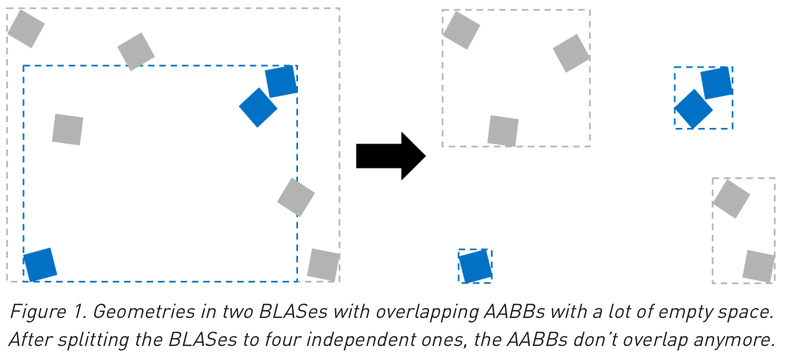
Optimization : deciding where to draw lines between:
- structure and solid (IAS and GAS)
- solids within GAS (bbox choice to minimize traversal intersection tests)
Where those lines are drawn defines the AS
https://developer.nvidia.com/blog/best-practices-using-nvidia-rtx-ray-tracing/
Optimizing Geometry : Merge BLAS when lots of overlaps
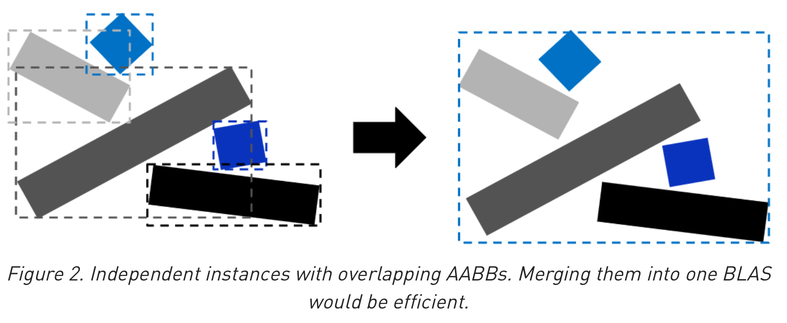
- lots of overlapping forces lots of intersections to find closest
- but too few bbox means the AS cannot help to avoid intersect tests
- balance required : needs experimentation and measurement to optimize
https://developer.nvidia.com/blog/best-practices-using-nvidia-rtx-ray-tracing/
Ray Intersection with Transformed Object -> Geometry Instancing
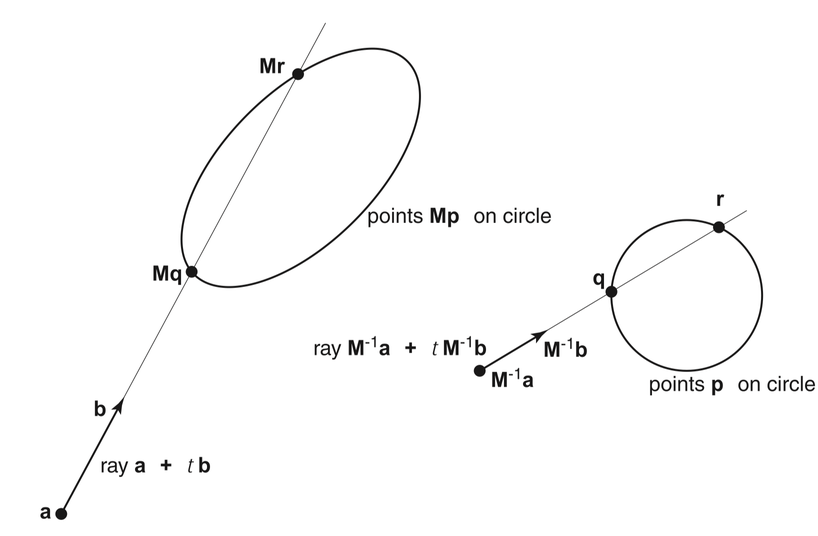
Fig 13.5 "Realistic Ray Tracing", Peter Shirley
Advantages apply equally to acceleration structures
Equivalent Intersects -> same t
- ray with ellipsoid : M*p
- M-1 ray with sphere : p
Local Frame Advantages
- simpler intersect (sphere vs ellipsoid)
- closer to origin -> better precision
Geometry Instancing Advantages
- many objects share local geometry
- orient+position with 4x4 M
- huge VRAM saving, less to copy
Requirements
- must not normalize ray direction
- normals transform differently
- N' = N * M-1T
- (due to non-uniform scaling)
G4Boolean -> CUDA/OptiX Intersection Program Implementing CSG
Outside/Inside Unions
dot(normal,rayDir) -> Enter/Exit
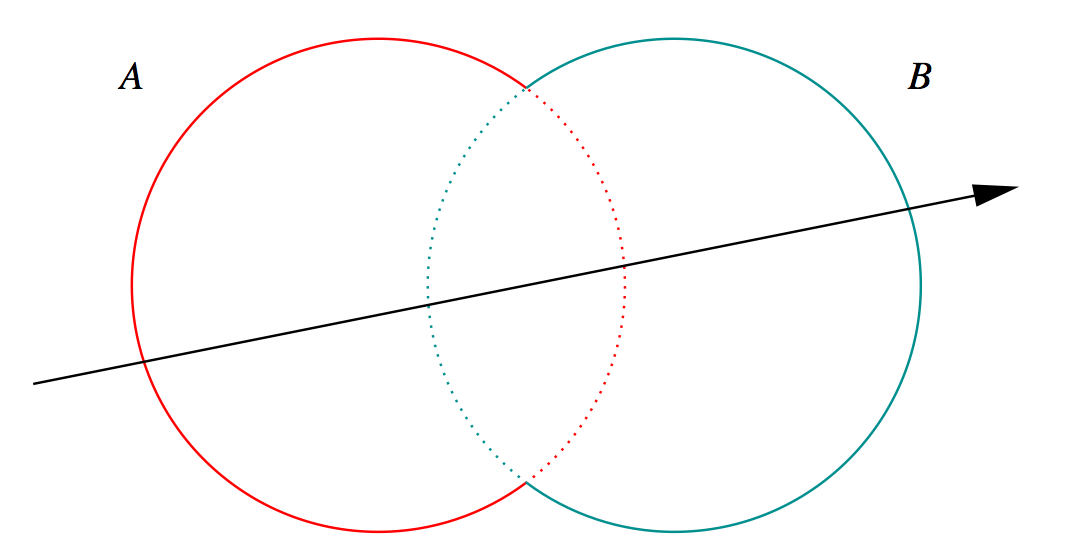

- A + B boundary not inside other
- A * B boundary inside other
Complete Binary Tree, pick between pairs of nearest intersects:
| UNION tA < tB | Enter B | Exit B | Miss B |
|---|---|---|---|
| Enter A | ReturnA | LoopA | ReturnA |
| Exit A | ReturnA | ReturnB | ReturnA |
| Miss A | ReturnB | ReturnB | ReturnMiss |
- Nearest hit intersect algorithm [1] avoids state
- sometimes Loop : advance t_min , re-intersect both
- classification shows if inside/outside
- Evaluative [2] implementation emulates recursion:
- recursion not allowed in OptiX intersect programs
- bit twiddle traversal of complete binary tree
- stacks of postorder slices and intersects
- Identical geometry to Geant4
- solving the same polynomials
- near perfect intersection match
- [1] Ray Tracing CSG Objects Using Single Hit Intersections, Andrew Kensler (2006)
- with corrections by author of XRT Raytracer http://xrt.wikidot.com/doc:csg
- [2] https://bitbucket.org/simoncblyth/opticks/src/tip/optixrap/cu/csg_intersect_boolean.h
- Similar to binary expression tree evaluation using postorder traverse.
Constructive Solid Geometry (CSG) : Shapes defined "by construction"
CSG Binary Tree
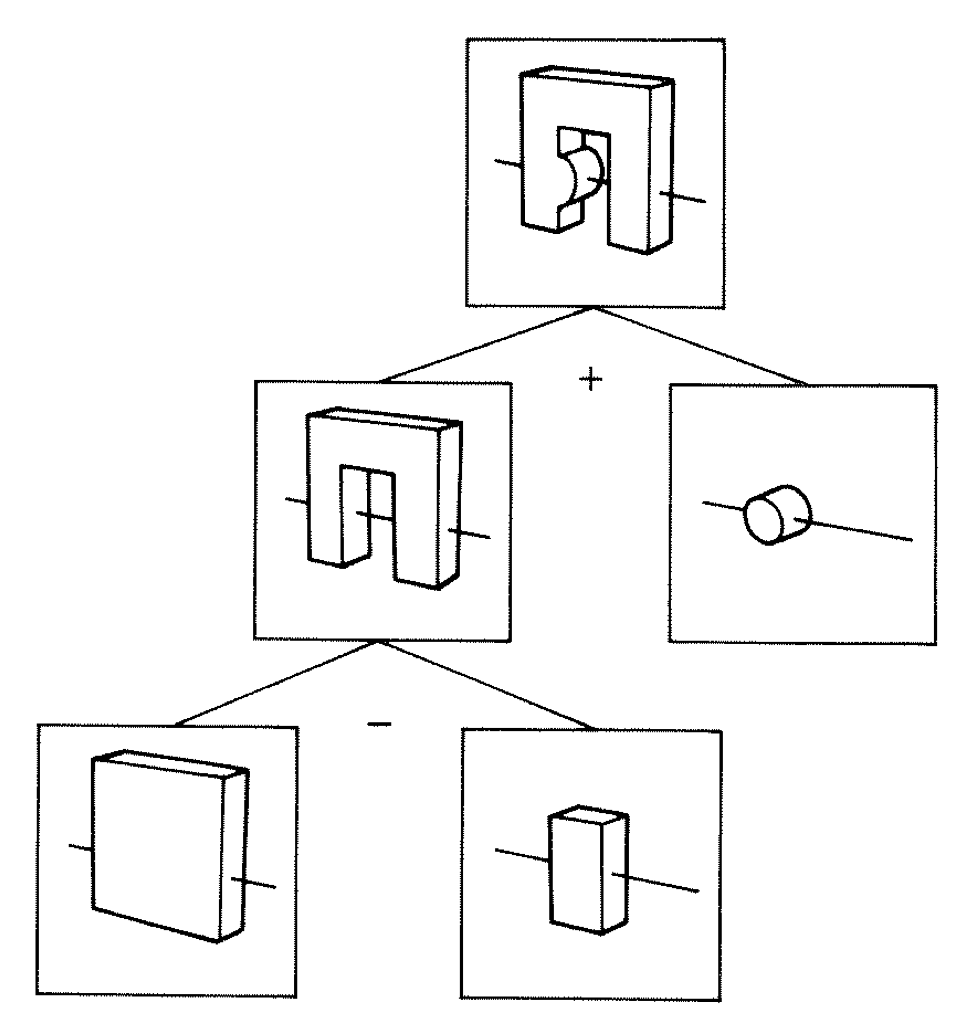
Primitives combined via binary operators
Simple by construction definition, implicit geometry.
- A, B implicit primitive solids
- A + B : union (OR)
- A * B : intersection (AND)
- A - B : difference (AND NOT)
- !B : complement (NOT) (inside <-> outside)
CSG expressions
- non-unique: A - B == A * !B
- represented by binary tree, primitives at leaves
3D Parametric Ray : ray(t) = r0 + t rDir
Ray Geometry Intersection
- primitive : find t roots of implicit eqn
- composite : pick primitive intersect, depending on CSG tree
How to pick exactly ?
CSG : Which primitive intersect to pick ?
In/On/Out transitions
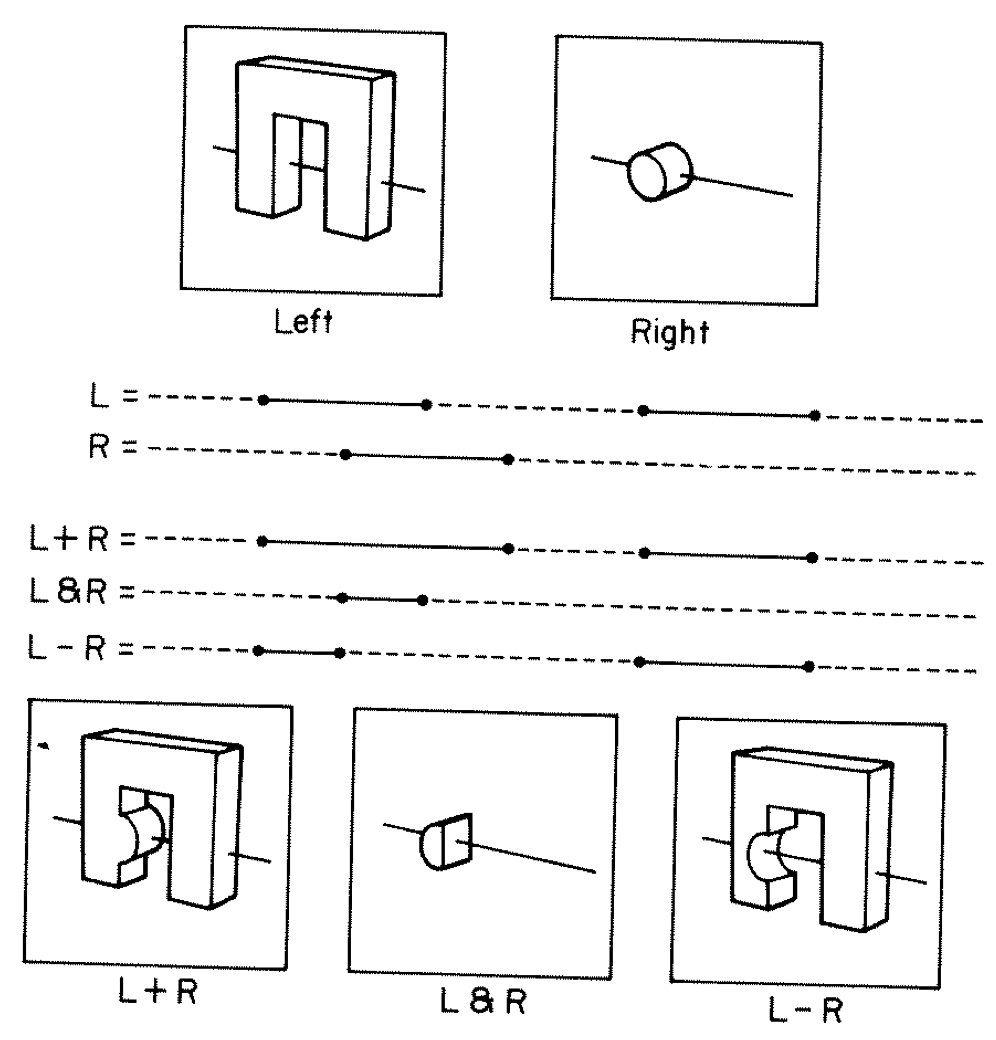
Classical Roth diagram approach
- find all ray/primitive intersects
- recursively combine inside intervals using CSG operator
- works from leaves upwards
Computational requirements:
- find all intersects, store them, order them
- recursive traverse
BUT : High performance on GPU requires:
- massive parallelism -> more the merrier
- low register usage -> keep it simple
- small stack size -> avoid recursion
Classical approach not appropriate on GPU
CSG Complete Binary Tree Serialization -> simplifies GPU side
Bit Twiddling Navigation
- parent(i) = i/2 = i >> 1
- leftchild(i) = 2*i = i << 1
- rightchild(i) = 2*i + 1 = (i << 1) + 1
- leftmost(height) = 1 << height
Geant4 solid -> CSG binary tree (leaf primitives, non-leaf operators, 4x4 transforms on any node)
Serialize to complete binary tree buffer:
- no need to deserialize, no child/parent pointers
- bit twiddling navigation avoids recursion
- simple approach profits from small size of binary trees
- BUT: very inefficient when unbalanced
Height 3 complete binary tree with level order indices:
depth elevation
1 0 3
10 11 1 2
100 101 110 111 2 1
1000 1001 1010 1011 1100 1101 1110 1111 3 0
postorder_next(i,elevation) = i & 1 ? i >> 1 : (i << elevation) + (1 << elevation) ; // from pattern of bits
Postorder tree traverse visits all nodes, starting from leftmost, such that children are visited prior to their parents.
Evaluative CSG intersection Pseudocode : recursion emulated
fullTree = PACK( 1 << height, 1 >> 1 ) // leftmost, parent_of_root(=0) tranche.push(fullTree, ray.tmin) while (!tranche.empty) // stack of begin/end indices { begin, end, tmin <- tranche.pop ; node <- begin ; while( node != end ) // over tranche of postorder traversal { elevation = height - TREE_DEPTH(node) ; if(is_primitive(node)){ isect <- intersect_primitive(node, tmin) ; csg.push(isect) } else{ i_left, i_right = csg.pop, csg.pop // csg stack of intersect normals, t l_state = CLASSIFY(i_left, ray.direction, tmin) r_state = CLASSIFY(i_right, ray.direction, tmin) action = LUT(operator(node), leftIsCloser)(l_state, r_state) if( action is ReturnLeft/Right) csg.push(i_left or i_right) else if( action is LoopLeft/Right) { left = 2*node ; right = 2*node + 1 ; endTranche = PACK( node, end ); leftTranche = PACK( left << (elevation-1), right << (elevation-1) ) rightTranche = PACK( right << (elevation-1), node ) loopTranche = action ? leftTranche : rightTranche tranche.push(endTranche, tmin) tranche.push(loopTranche, tminAdvanced ) // subtree re-traversal with changed tmin break ; // to next tranche } } node <- postorder_next(node, elevation) // bit twiddling postorder } } isect = csg.pop(); // winning intersect
https://bitbucket.org/simoncblyth/opticks/src/tip/optixrap/cu/csg_intersect_boolean.h
CSG Deep Tree : Positivize tree using De Morgan's laws
Positive form CSG Trees
Apply deMorgan pushing negations down tree
- A - B -> A * !B
- !(A*B) -> !A + !B
- !(A+B) -> !A * !B
- !(A - B) -> !(A*!B) -> !A + B
End with only UNION, INTERSECT operators, and some complemented leaves.
COMMUTATIVE -> easily rearranged
1st step to allow balancing : Positivize : remove CSG difference di operators
... ...
un cy
un cy
un cy
un cy
un cy
di cy
cy cy
... ...
un cy
un cy
un cy
un cy
un cy
in cy
cy !cy
